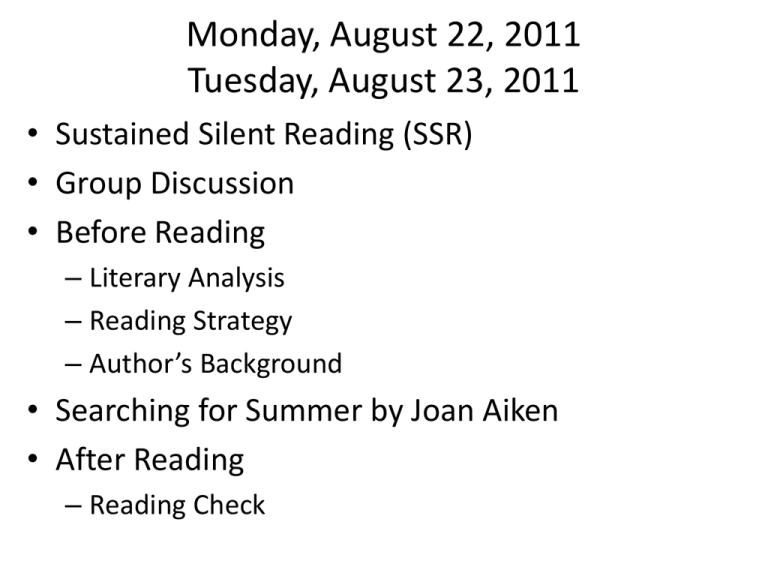Unit 5: Plot, Setting, and Mood
advertisement

Monday, August 22, 2011 Tuesday, August 23, 2011 • Sustained Silent Reading (SSR) • Group Discussion • Before Reading – Literary Analysis – Reading Strategy – Author’s Background • Searching for Summer by Joan Aiken • After Reading – Reading Check Unit 4: Searching for Summer Short Story by Joan Aiken What do you take for GRANTED? Searching for Summer Objectives • Literary Analysis – Explore the key idea of appreciation – Analyze setting and mood – Read a short story • Reading – Monitor State Standards • Reading Standards – E2-1.4 Analyze Plot – E2-1.5 Analyze the effect of the author’s craft Searching for Summer • • • • • Key Idea: What do you take for GRANTED? Literary Analysis: Setting and Mood Reading Skill: Monitor Author Background: Joan Aiken Background Information: – Nuclear Anxiety – Nuclear Winter Searching for Summer • What do you take for GRANTED? There are many things in life that we assume will always be there. Air and water too. But what if they disappeared? You may have heard the saying “You never miss the water until the well runs dry.” That means that we don’t have appreciation for certain tings until they’re gone or scarce. What are some everyday things we take for granted? What would you do if this thing were suddenly gone or in short supply? Searching for Summer • Literary Analysis: Setting and Mood A story may have more than one setting, and each setting may convey a different mood, or atmosphere. What might be the atmosphere in a stadium packed with students watching an important game? What then would be the mood? Imagine how the mood would change if a character walked out of the stadium into a dimly lit, deserted corridor. To understand the relationship between setting and the mood in a story, think about - The descriptive details that tell what a place is like - The feelings conveyed by those descriptive details As we read, notice the descriptions of each setting and think about the mood those details convey. Searching for Summer • Reading Skill: Monitor When you monitor, you check to make sure you understand what you are reading. If you don’t understand a story, you may have to read more slowly, reread passages, or read aloud. As you read today, you will stop and answer the “MONITOR” and “SETTING AND MOOD” questions in the margin of the text. Searching for Summer • Background: Nuclear Winter The setting described in “Searching for Summer” is not merely the result of one writer’s imagination. The setting mirrors a situation that scientists now call Nuclear Winter. In the 1980s, scientists began predicting that Nuclear Winter would be a likely outcome of a nuclear war. Scientists estimated that nuclear bombs would generate huge quantities of dust and soot, which would be carried into Earth’s atmosphere. There, the dust and soot would absorb sunlight. As a result, less sunlight would reach the ground, and days would become dark and overcast. Plants would not receive enough light for photosynthesis, and temperatures would plummet. These details are almost identical to those imagined by Aiken in this story which was written in the 1950s. Searching for Summer • Key Idea: APPRECIATION Looking at lines 13 – 27 What details show that the people in this story have an appreciation of sunlight? Searching for Summer • Key Idea: APPRECIATION Looking at lines 90 – 102 How does Mr. Noakes give you an appreciation for ordinary courtesy and decency? Searching for Summer • Key Idea: APPRECIATION Looking at lines 154 – 156 Why will William show an appreciation for hearing company? Searching for Summer • After-Reading: Discussion – Think about the characters in the story. Discuss if each character got what they deserved. Give reasons for your answer. – Would another ending have been better? Searching for Summer • After-Reading: Reading Check Using complete sentences, answer the following questions on page 71 of your Literature Book: Comprehension: 1 – 4 Literary Analysis: 5, 6, 8, 10, & 11 Literary Criticism: 12 Searching for Summer Wrap-Up (In groups of 2 – 4) - Imagine that Mr. Noakes found the Hastings cottage and has turned the woods into a vacation spot. - Create a brochure for his new resort. You must think of a name for the resort, describe the resort in one or two paragraphs, and include a picture of the resort. - A successful brochure will…. - Use vivid, colorful language to describe the setting - Convey a mood that makes people want to visit







